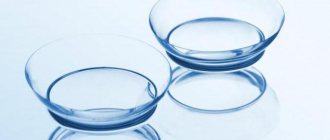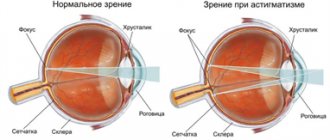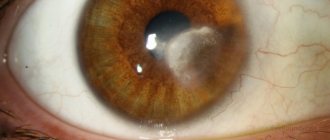What is astigmatism?
Astigmatism is a condition where the cornea or lens is irregularly shaped, causing light to refract differently and produce blurry images.
To determine the extent of the disease, it is necessary to identify the degree of the meridian through which the light rays pass. The scale ranges from zero to one hundred and eighty degrees.
The causes of astigmatism cannot be determined precisely. It may be congenital or develop over time.
If no measures are taken, astigmatism will develop and may be accompanied by such unpleasant things as:
- strabismus;
- frequent headaches;
- itching and cutting sensation in the eyes.
The disease is treated in the following way:
- wearing special glasses;
- orthokeratology;
- laser surgery;
- wearing toric lenses.
Cylindrical lenses for astigmatism photo
With astigmatism, the patient loses clarity of vision due to changes in the normal shape of the eye, cornea or lens.
To compensate for this defect, spherical optical lenses are used, but they are not able to completely cure astigmatism.
Lack of treatment for astigmatism threatens a sharp decrease in visual acuity and even strabismus. The patient will also experience constant headaches and pain in the eyes.
Astigmatism causes negative changes in the cornea of the lens or eye, disrupting its uniform curvature. This phenomenon is accompanied by distortion of vision: light rays do not converge in the retina at one point, as usually happens in a healthy eye.
In the photo: vision with astigmatism
The image on the retina is formed in a modified form: in the form of an infinity sign, a segment or an ellipse with blurred boundaries. Occasionally, patients are unable to see images of vertical lines.
The development of astigmatism begins in childhood, the disease is accompanied by myopia or farsightedness and is finally formed in the first years of life.
Timely diagnosis of the disease in the early stages is a guarantee of successful treatment . Visual diseases, especially progressive ones, are generally difficult to treat.
It is better to be cured in childhood, when the visual organs are not yet fully formed.
Special spherical lenses are used to make glasses that treat astigmatism. They are a spherical lens stretched in opposite planes, similar to part of an oval with an unevenly curved surface.
Cylindrical lenses for astigmatism (photo below) are one of the types of astigmatic lenses. Their peculiarity is the presence of an axis in the direction of which the optical effect does not manifest itself. And in the direction perpendicular to the axis, the lens acts like a regular spherical one.
These photographs show: spherical and cylindrical lenses, their varieties and shapes, as well as people wearing glasses with astigmatism.
Wearing glasses with cylindrical lenses allows you to correct the difference in refraction of two eye meridians - with simple astigmatism, when refractive errors are noted in one meridian.
A cylindrical lens looks like a segment of a cylinder. There are diverging and collecting lenses.
There are also toric lenses that are necessary for the treatment of mixed or complex astigmatism.
In young patients, especially those under two years of age, it is difficult to determine astigmatism .
Due to their age, children do not complain about vision problems, not understanding that the perception of the world around them with double and stretched objects is abnormal.
Children with astigmatism may not talk about visual distortion, but complain about a headache.
The child becomes apathetic, refuses to read, draw, write and other activities associated with visual stress. Often parents do not sound the alarm, thinking that their baby is simply being capricious.
But diagnosis is necessary if a child exhibits symptoms:
- Difficulty reading;
- The baby constantly squints and tilts his head;
- Difficulty focusing;
- Tired eyes;
- Headache;
- Split image, lack of clear contours.
If you notice any of the above signs, you should immediately contact an ophthalmology clinic.
Vision diseases require very sensitive treatment. To treat astigmatism, laser correction surgery is necessary, and in the early stages of the disease, wearing glasses is sufficient. But no doctor gives a 100% guarantee of success. This is what people who have cured or are trying to cure astigmatism write.
Irina Nikolaevna: “After the operation, my vision improved. But... I had to go back to work after three days. I experienced terrible discomfort in my eyes for the first week and a half. I advise everyone to stay at home after the operation - the eyes must adapt.”
Roman: “The correction of astigmatism was successful - vision became much better, astigmatism remained a little in the right eye.”
Valentina: “After the operation I didn’t notice any significant improvements.”
See inaccuracies, incomplete or incorrect information? Do you know how to make an article better?
Would you like to suggest photos on the topic for publication?
Please help us make the site better! Leave a message and your contacts in the comments - we will contact you and together we will make the publication better!
A visual impairment called astigmatism can be easily corrected. It can be corrected using glasses for astigmatism, hardware methods and surgery.
A person who suffers from this disease has difficulty seeing objects (blurry). This can be completely compensated for by using special spectacle lenses. To do this, the doctor prescribes wearing glasses with cylindrical or toric lenses. They are divided into scattering and collecting.
When you first start wearing glasses, they will take some getting used to. It is necessary to wear them during the day until bedtime, then after about a week the image through the lens will be clear and clear. If there is no improvement, it means that the glass was chosen incorrectly.
Wearing astigmatic lenses has certain important points:
- Over time, the frame becomes deformed. Then, after a certain period of time, it is necessary to replace it. A deformed frame creates visual discomfort;
- glasses are a factor causing stress in a patient who has not previously used them;
- if the form of the disease is advanced or occurs with complications, it will take a longer period of time to get used to it;
- the choice of frame should be the most neutral option, otherwise it will be difficult to combine it with clothes and other accessories;
- glasses lenses fog up.
The tolerability of optics is influenced not only by the degree of disease, but also by the age of the patient.
The older the age, the longer and more complex the adaptation period. For those who are faced with astigmatism, it is important to adapt to the use of optics as gently as possible. Sudden fluctuations in perception can make the problem worse.
The ophthalmologist determines how much glasses are needed. He can choose the appropriate vision correction: the use of contact lenses, cylindrical or toric glasses, the possibility of laser correction.
The cost of glasses depends on the frame option and the complexity of the optics. Ready-made options made at the factory are much cheaper, but are often not suitable, because cases with astigmatism are individual. To speed up the healing process and wear comfortably, you should purchase an option that suits you directly.
When choosing a frame, it is worth considering different options. On our website we present various photos of glasses for astigmatism and other vision diseases.
Only a specialist can make the correct selection of glasses for astigmatism. To make wearing glasses comfortable, you need to undergo a number of diagnostic tests.
If you experience side effects from use (dizziness, nausea, eye pain), stop wearing or use special drops.
Astigmatism occurs in two types:
- Congenital. It appears in early childhood. In this case, timely consultation with a doctor and wearing lenses can completely correct vision. If the excess goes beyond 1 diopter, then you will have to wear glasses constantly.
- Acquired. May occur as a result of injury and surgery. Scars that change the cornea cause vision abnormalities.
This type is diagnosed when the reading is up to 3 diopters. In this case, the use of cylindrical or toric lenses is prescribed. To begin with, weak glasses are installed, which after several months are replaced with stronger ones. It is impossible to choose such a medical accessory on your own. To do this, you need to undergo a series of examinations with an ophthalmologist, and only after that he will be able to write you a prescription.
With a complex type of disease, intolerance to some lenses occurs. It is recommended to combine glasses and contact lenses to correct the situation.
This form most often develops due to injury and congenitally. In this case, combined versions of cylindrical and spherical glasses are used. Most often, doctors recommend using individually selected glasses for safe correction.
Disadvantages of wearing optical glasses may include:
- individual intolerance;
- cosmetic inconveniences.
Please note that intolerance may depend on the age of the patient. Adaptation takes a longer period in case of a complex form of the disease.
If the patient experiences discomfort during use, you need to check the manufactured glasses with the prescription issued for them. If no errors are found, you should go to the doctor and state the problem, which can be corrected by prescribing additional examinations.
Today, spectacle correction is the most common and popular method. Compared to surgery, it is much more affordable. Glasses are cheaper and can be purchased at any optician, and can also be restored with a prescription if you lose them or they break.
However, you need to know that complex glass has its drawbacks. These include limiting the viewing space and reducing the image. With a high degree of disease, the use of optical glasses is less convenient.
To reduce discomfort, you need to seek help from highly qualified doctors. You need to regularly come for appointments and be examined by a doctor while wearing glasses. In this case, you can control the treatment and promptly change the glasses to stronger ones.
In old age, you need to be more attentive to doctor's visits and changes in your vision. It is these people who are more likely to experience side effects such as poor tolerability of lenses. Only high-quality and correctly selected lenses can improve vision and correct astigmatism.
Important! Seek eyeglass referrals from vetted and recommended eye care professionals. It is also necessary to regularly visit a medical facility and consult with the doctor of your choice.
Both glasses and contact lenses are similar methods of correction. However, there are a number of differences. Lenses can provide a more complete picture. They help you perceive the world around you naturally, while avoiding the prismatic effect. However, there are more disadvantages to using them.
How to choose glasses - shown in the video
The choice of lenses and glasses is made individually, and there is no identical option for everyone. For some, wearing complex glasses is not a problem, while others will not be able to even wear ordinary ones. They are selected for a short period of time, and their condition must be constantly monitored and the glass replaced. In addition, fogging of spectacle lenses causes discomfort when used in winter. But, despite all this, they remain the most popular and widespread form of correction of vision defects.
How helpful was the information in this article? You can now evaluate the disadvantages and advantages of using glasses, and then make your choice. Write how this happened for you or your child. Perhaps you have additions and recommendations on how to select spectacle correction.
Astigmatism develops due to a violation of the curvature of either the cornea or the lens of the eye, which with this disease takes on an oval shape. As a result, a person sees only a distorted image.
One way to correct this problem is to use specially selected models..
The glasses that are selected by an ophthalmologist for this patient’s disease are quite complex optics that have several important features.
In addition, after special processing, such a lens is practically no different from a regular oval.
Selecting glasses for astigmatism is necessary only with the help of a specialist .
The ophthalmologist will conduct a thorough examination of the patient's eyes and write a prescription, and may also give some advice regarding their use.
Important! Self-treatment in these cases is not recommended to avoid complications of eye disease.
In some cases, products for this disease use cylindrical lenses, which make it possible to correct the difference in refraction of the two main eye meridians . They look like small segments of a regular cylinder, and are divided into collecting and scattering.
Their main feature is the presence of an axis (the direction in which they have no optical effect) . In the opposite direction to it there is a focus, due to which these lenses have exactly the same effect as ordinary spherical ones.
Models with this structure can refract exclusively light rays incident perpendicular to the axis.
As a rule, a specialist prescribes models with cylindrical lenses for people suffering from a disease in a simple form, characterized by the manifestation of refractive error of the eyes only in a particular meridian.
For patients who have complex or mixed forms of the disease, it is necessary to select
correction means
, into which special toric lenses are inserted.
Toric lenses are a correctly calculated combination of spherical lenses with cylindrical ones . They effectively refract the flow of light rays along two meridians at once, each of which has a certain refractive power.
When hypermetropic type astigmatism is detected, the doctor prescribes to the patient models that have collective lenses . They are intended to correct vision only in the horizontal meridian.
When an ophthalmologist prescribes a prescription for glasses, the transcript must necessarily contain the exact placement of the lens axis, as well as their required refractive power . An international designation is used for this.
It should be noted that degrees should be counted in the direction from right to left, starting from the horizontal meridian of the eye lens .
So, for example, if a patient has direct myopic astigmatism of a simple form of three diopters, this means that he has a violation in the vertical meridian - three diopters, but there are no violations in the opposite meridian.
Important! In this case, in the prescription, the specialist specifies frames with concave lenses that have a cylindrical shape.
The glass is adjusted to three diopters, and its horizontal axis is 0°. Glasses do not correct horizontal meridian refraction.
The selection of glasses for astigmatism in adults should be carried out with the help of an experienced ophthalmologist.
We need to pay very close attention to the issue of
how to choose glasses
for astigmatism for older people.
After all, these categories of patients differ not only in their tolerance to optics, but also in the possible manifestation of various adverse reactions: headaches and frequent dizziness, a feeling of pain and discomfort in the eye area.
To ensure high-quality vision and correct correction of the disease, properly selected special models are required; simple lenses are not suitable in this case.
Thus, an adult undergoing a corrective procedure for the first time does not need to be prescribed optics that completely correct the disease .
To begin with, he needs products with weaker glasses in order for addiction to occur. After a few months, you can use lenses with a more effective corrective effect.
When the patient can get used to them, the doctor needs to prescribe him completely corrective.
Choosing a good frame that has
toric lenses
. Most patients are forced to change them several times to find the most suitable option.
In this case, lenses are selected individually for each individual case after a thorough eye examination by an experienced specialist.
You can find out that the glasses were chosen incorrectly if a person’s complaints of discomfort do not disappear even after wearing them for several weeks.
After the appointment, you should regularly visit an ophthalmologist, and also, if necessary, change them to optics with stronger or weaker lenses.
Highly qualified specialists advise their patients suffering from this eye disease to wear glasses all the time.
Attention! It is extremely important to identify the presence of this disorder in childhood, because at the beginning of the development of the disease it is much easier to correct it with the help of glasses.
In addition, special glasses allow a person to see a high-quality image of the world around them.
It should be remembered that treating astigmatism with glasses is completely impossible..
Patients with this disease also should not forget that even the most suitable models are only an option for the temporary correction of such a disorder, but they cannot be used to cure this disease.
On the territory of the Russian Federation, the average price for glasses , which are intended to correct this type of visual impairment, is approximately 17-20 thousand rubles .
You can learn more about how to choose vision correction for this disease in this video:
People with such visual impairments should not refuse to wear special models, citing, for example, an unaesthetic appearance as a reason.
After all, properly selected glasses help correct vision impairment and improve its quality . However, such optics are not able to help completely get rid of the disease.
Unlike myopia and farsightedness, astigmatism is a more complex pathology. Correcting astigmatism requires correction in the vertical and horizontal planes. This is due to the fact that with this disease the eye takes on an oval shape, and all objects, regardless of distance, are seen fuzzy and blurry. To correct vision, glasses with a special lens configuration are used.
The use of special glasses is the most affordable and easiest way to correct vision for astigmatism. Based on the complexity of this disease, the selection of glasses can only be carried out by an ophthalmologist. Incorrectly chosen glasses can cause visual impairments, which include:
- worsening astigmatism;
- strabismus;
- amblyopia.
With amblyopia, one eye is completely excluded from the vision process. Such visual impairment cannot be corrected optically.
Amblyopia
Some patients with mild manifestations of astigmatism ignore the testimony of an ophthalmologist and do not wear glasses for cosmetic reasons. This should not be done, and glasses should be worn immediately after diagnosis.
Cylindrical lenses for special glasses have a special configuration. Unlike conventional lenses, the optical cylinder focuses the light beam not into a point, but into a line. Such a lens has an axis where optical properties do not appear. Cylindrical lenses designed to correct astigmatism can be of two types:
- converging lenses;
- diverging lenses.
Toric lenses are used to correct mixed astigmatism. This pathology is characterized by two types of vision distortion, when farsightedness is determined along one eye meridian, and myopia along the other. A toric lens is a combination of a spherical and a cylindrical lens and has a complex surface design.
There are certain wearing rules for astigmatic glasses. If the diagnosis of astigmatism was made in childhood and the child immediately began wearing glasses, then getting used to them is easier. Adults who have just started wearing such glasses may experience some negative reactions:
- headache;
- dizziness and imbalance;
- painful sensations in the eyes.
Therefore, ophthalmologists recommend not to wear astigmatic glasses all the time at first, but to get used to them gradually, increasing the time you spend in these glasses every day. It is believed that 7-8 days are enough to get rid of unpleasant sensations. If after this period they do not stop, you should urgently visit a doctor. For better adaptation, the ophthalmologist first prescribes glasses with weak diopters, which the patient wears for several months. Then the glasses are changed to stronger ones. And only then, in the case of normal adaptation, the patient is prescribed optimal glasses. Glasses should be put on immediately after waking up and worn until discomfort occurs . After this, you should give your eyes a rest and put your glasses back on.
Corrective glasses are ordered in optical stores according to a prescription prescribed by a doctor. If for several days the patient continues to see everything around him blurry or with double contours, then the reason for this may be the following:
- the glasses received do not correspond to the prescription;
- optical glasses were installed incorrectly;
- poorly chosen frame.
In this case, you need to visit a salon, where all complaints should be resolved.
Due to the nature of astigmatism, choosing the right frame is just as important as having the right and well-fitting lenses. Frames that are too massive will have to be eliminated immediately, as there is a risk of distortion of peripheral vision. The upper edges of a properly sized frame should touch the temple area without squeezing it. A straight line drawn across the top edges of the nostrils will indicate where the bottom edge of the frame should be.
With a correctly selected frame, the optical center of the lens should be strictly in the middle of the eye.
In order to choose the correct corrective lenses, the ophthalmologist uses various diagnostic tools. These include a keratoscope and a keratometer. They allow you to record changes in the cornea and determine the amount of astigmatism. To date, the most accurate method for determining this pathology and its characteristics is computer topography of the cornea.
Spectral optical coherence tomography is a high-frequency non-contact method for diagnosing the morphology of the cornea, retina and optic nerve.
In addition to the optical characteristics that determine the configuration of the lens, there is a selection of lenses based on the material of manufacture. The lens material used to correct astigmatism may be glass or plastic . Each material has its own advantages and disadvantages. Modern plastic has high transparency and low weight. In addition, plastic lenses are noticeably cheaper than glass ones, but this material quickly scratches and fades over time. Lenses made from optical glass have a number of important advantages:
- wear resistance;
- mechanical strength;
- high optical parameters;
- protection against infrared radiation.
Modern glass is almost impossible to scratch and small grains of sand will not cause any mark to such glasses. Optical glass is very durable and the opinion that lenses can break and injure your eyes is unfounded. Due to the high refractive index, the thickness of the lenses can be much thinner than plastic ones. In favor of glass lenses is the fact that they perfectly protect the eyes from solar infrared radiation, which is not typical for plastic lenses.
Since the ophthalmologist only writes a prescription, and the patient must order glasses on his own, you should pay attention to some nuances. When ordering glasses, you need to focus on lenses with anti-reflective coating. It reduces reflected light and reduces eye fatigue. When ordering plastic lenses, please specify the protective coating applied to them . This will extend the life of astigmatic glasses for a long time.
Selection of glasses for astigmatism
Prescription glasses should be checked immediately. They should fit well in shape and not cause visual strain when looking from close to distant objects and vice versa.
Along with the use of astigmatic glasses, it is also necessary to use some auxiliary means. These include eye drops Taufon and Emoxipin. In the early stages of the disease, eye gymnastics is very helpful. There are various sets of exercises that must be agreed upon with an ophthalmologist.
Only a doctor can recommend the use of any medications.
Corrective glasses are considered the most convenient and economical treatment for astigmatism. But you should know that an advanced disease will require a lot of time to adapt. The age of the patient also plays an important role. Timely detection of pathology reduces the time for treatment and rehabilitation.
Toric lenses
All of these special lenses are made from the same material as regular lenses, which are called spherical lenses. So then what do toric contact lenses mean? The fact is that they consist of two optical forces, the curvature of which is at different angles. One is needed to correct astigmatism, the other for myopia or hyperopia. They are designed in such a way that the lens does not move from the cornea during blinking or eye movement. That is, if a spherical lens can move freely along the cornea, then for a toric lens this is unacceptable. They must be fixed on the eye.
Toric contact lenses are of the following types:
- soft or hard;
- one-day or long-term wear;
- colored.
Doctors recommend wearing toric lenses only for patients with astigmatism, but also for diseases such as:
- cataract;
- diseases and injuries of the cornea.
The appearance of toric lenses is a combined spherical and cylindrical shape.
Based on their composition, lenses are divided into hydrogel and silicone hydrogel. The main difference is the method of air passage: through water or a silicone component.
Selection tips
The selection of toric lenses compared to traditional spherical correction is quite complex and troublesome, so the selection of astigmatic glasses and/or toric contact lenses must be carried out by a qualified specialist.
Selection rules
There are several methods for selecting TCLs, but in most cases the algorithm for selecting TCLs is initially the same as for astigmatic glasses. This means that your doctor will first write a prescription for astigmatic glasses and then convert it into a prescription for toric contact lenses.
First of all, the spherical and cylindrical components of optical correction are determined, as well as the angle of inclination of the cylinder axis for each eye separately. This is followed by the conversion of spectacle correction based on special tables into toric soft contact lenses.
In this case, keratometry data (objective measurement of the geometric dimensions of the cornea) must be taken into account to determine the radius of the base curvature of the lenses (BC). Determining the biological tolerance of contact lenses is also very important.
The specific tolerance of TCLs is associated with their greater thickness than conventional spherical soft CLs. For the same reason, in order to avoid hypoxic complications, you should under no circumstances abuse the prolonged and continuous wearing regimens indicated in the instructions.
In these modes, lenses are worn only when absolutely necessary. In terms of speed of adaptation, toric lenses have an obvious advantage over spectacle correction of astigmatism, since people very quickly get used to lenses of this type and more easily tolerate full correction.
Doctors know that when determining refraction (the degree of vision distortion), they should never use an old glasses prescription, since this prescription may not have been written for full, but for tolerable spectacle correction.
Despite the clear need for toric colored lenses, only a few manufacturing companies produce such optical models for the correction of astigmatism. Let's consider several brands from different manufacturers.
MAXVUE VISION
Toric color contact lenses from MAXVUE VISION have greater refractive power in certain areas, which reduces the impact of corneal astigmatism. Model and series options:
- ColourVUE and Phantasee - models of the aforementioned Malaysian company - are the most common, sold in more than forty countries around the world.
- Color VUE are colored contact lenses designed to correct astigmatism for patients who want to change their appearance depending on the chosen style. This is the most popular series of Big Eye models.
- Color VUE Toric is a Gorgeous Gray terpolymer hydrogel lens featuring a toric design and enhanced stability, anti-lens rotation and precise axis correction.
A mysterious gray color with a strength of 0 to -9 diopters will change the natural shade of the eyes and shine with new colors with brownish sparkles. These lenses look very nice on dark-eyed users and will add brightness and definition to those with light eyes.The front surface of the lens is chiseled, while the back is formed by injection molding. All this makes these lenses with a three-month wearing regime comfortable and almost imperceptible on the eye.
MAXVUE products are in demand in 40 countries around the world, and the number of contact lens models, including colored toric options, is increasing from year to year. This is achieved through a relentless pursuit of improvement in design, quality and customer service, as well as through extensive research activities of our employees.
Bausch & Lomb
Wonderful colored toric lenses Pure Vision Toric are unique optical correction devices from Bausch & Lomb. Let's consider models that successfully correct astigmatism:
- Pure Vision Toric - colored (or more correctly, tinted) lenses that eliminate discomfort in the eyes and literally save you from headaches - a frequent companion of astigmatism. These lenses easily compensate for corneal defects and provide excellent vision.
- Pure Vision Toric from Balafilcon A, with a diameter of 14 millimeters, fixes the lenses in the desired position even when blinking, thanks to weights in the lower part. These lenses are designed for monthly wear and are tinted in a bluish color. They have good oxygen permeability, which allows you to enjoy a clear image very clearly from different viewing angles.
Cooper Vision
Proclear Toric lenses from Cooper Vision are also tinted bluish and are excellent for treating astigmatism. The particular convenience of these lenses is that they remain moisturized up to 96% even after 12 hours of continuous use.
The company has introduced a new contact technology (PC Technology), which uses a unique material that exactly imitates the enzymes contained in human cell membranes.
The molecules of this material attract and surround the lenses with moisture, providing a natural environment for the cornea and lens. Cooper Vision has created a lens with an excellent moisture content of 62%, using the excellent properties of Omafilcon A.
Ciba Vision
Speaking about colored toric lenses, one cannot fail to mention another brand of blue-tinted lenses designed to correct myopia and hypermetropia complicated by astigmatism. Toric lenses Air Optix for Astigmatism from Ciba Vision are daily wear models with different degrees of refraction.
Their oxygen permeability is quite high - 110 units, thanks to the innovative material - silicone hydrogel. These lenses are developed using Lotrafilcon B using the plasma polymerization method. Air optix For astigmatism contains a comfortable weight for correct placement on the eye and 33% water.
The excellent new toric lens design of these lenses makes them comfortable from first insertion, providing a wide optical field of view and rotational stability while minimizing eyelid contact with the lens.
When choosing this or that model, remember that to order toric lenses in any optics store, in addition to diopters, you need to know the parameters of the cylinder. In the selection of toric colored lenses with diopters, the participation of an ophthalmologist is very important. Only a specialist can accurately determine which lenses are suitable for the patient.
Types of contact lenses
Today's toric contact lens market looks like this:
1. Johnson & Johnson:
- Acuvue Oasys for Astigmatism;
- “1 Day Acuvue Moist for Astigmatism”;
- Acuvue Advance for Astigmatism.
2. CooperVision:
- “Biofinity Toric”;
- Biomedics Toric;
- “Proclear Toric”;
- Avaira Toric;
- Frequency 55 Toric XR;
- “Proclear Toric XR”;
- “Vertex Toric”;
- "Ultra Flex Toric" (UltraFlex Toric);
- “Preference Toric”;
- “Vertex Toric XR”;
- “Clariti 1day toric”;
- "ClearSight 1 Day Toric".
3. Alcon:
- Air Optix for Astigmatism;
- "Dailies Aqua Comfort Plus Toric" (Dailies AquaComfort Plus Toric);
- Focus Dailies Toric.
4. Bausch & Lomb:
- “Soft Lenses for Astigmatism” (SofLens For Astigmatism);
- "Pure Vision Toric" (PureVision Toric);
- “Pure Vision 2 for Astigmatism”;
- “Soft Lenses Daily Disposable for Astigmatism” (SofLens Daily Disposable for Astigmatism);
- Optima Toric.
5. “X-Cel”:
- “Extreme Ashdvao 54%” (Extreme H2O 54%);
- “Extreme H2O 54% Toric MC”.
Daily and daily lenses
Daily toric contact lenses are the cheapest option. They must be removed every day at night and placed in a container with a special solution in which they will be disinfected. You also need to adhere to the planned replacement schedule. Wearing time varies depending on the type and brand - from two weeks to three months.
Daily toric contact lenses are changed every day. They cost more, because you constantly need a new pair. But these lenses are good because biological deposits do not accumulate on them and there is no constant need for disinfection.
Classification of lenses
The entire variety of contact lenses produced today can be classified according to several criteria.
- By time of scheduled lens replacement:
- one-day;
- two weeks;
- period;
- quarterly;
- traditional (service life 6-9 months).
- According to wearing mode:
- daytime - can be used for 8-10 hours, they must be removed at night;
- extended wear lenses – can be worn without removing, depending on the brand, from 1 to 7 days.
- Depending on the material of manufacture:
- soft contact lenses;
- hard contact lenses;
- Special Design Lenses:
- spherical – most traditional contact lens models;
- aspherical – have improved optical characteristics;
- toric – designed to correct astigmatism;
- multifocal – have several zones with different optical powers, suitable for correcting presbyopia;
- orthokeratological - special lenses that are worn while sleeping at night to temporarily improve visual acuity during the day;
- therapeutic – used for temporary protection of the corneal surface after microsurgical operations;
- color contact lenses;
- carnival lenses (crazy).
There are three main types of colored contact lenses: decorative, tint and cosmetic. What is important is that colored contact lenses are used not only by people with good vision, but also by those who suffer from myopia, astigmatism or farsightedness.
Most colored lenses are designed to be reusable, but disposable ones are also available. The high ability to transmit oxygen creates comfortable conditions for the eyeball to function normally.
It is worth noting that even ordinary “non-colored” contact lenses for vision correction have a barely noticeable bluish or greenish tint. Manufacturers make this move to make the lens easier to distinguish in solution, or if it suddenly falls. Such a light tint of the contact lens does not affect the color of the eyes.
- Tinted colored contact lenses are transparent, their color is only slightly richer than that of regular contact lenses. They are worn to emphasize the beauty and expressiveness of the eyes, and to slightly change their color. Such lenses are suitable exclusively for those with light eyes, because for brown-eyed people they simply will not be noticeable.
- Cosmetic lenses are distinguished by the fact that they are opaque, due to which they can radically change the color of a person’s eyes. For example, even dark brown eyes can be easily turned into light blue with the help of such lenses. Thus, if you have dark eyes, you will need just such lenses to change the natural color of your eyes. It is worth noting that today manufacturers offer a huge variety of colors, ranging from classic ones - green or blue, to exquisite and fancy colors - amethyst, lavender, mint, etc.
- Decorative lenses are also called carnival or Crazy lenses. These are bright, extravagant lenses with fancy colors or patterns that allow you to surprise or even shock others. They are often used for theme parties, carnivals, etc. Such lenses can, for example, imitate a cat's eye and come in the most incredible colors.
It is important to remember that carnival lenses are not suitable for constant daily wear, since they are significantly thicker than ordinary lenses, and, accordingly, their ability to pass air is worse. Visual acuity and contrast perception in such lenses is significantly reduced.
Soft and hard lenses
Rigid toric contact lenses are also called gas permeable. This is due to the fact that they are made from special polymers that have high oxygen conductivity.
Their advantage is that they hold their shape very well on the eye. Sometimes doctors advise wearing such lenses at night and taking them off in the morning. During this time, they act on the cornea so that it becomes a little flat. As a result, the curvature around it increases and vision becomes clearer. This effect lasts throughout the whole day.
Soft toric contact lenses are a relative newcomer to the market. They are also gas-permeable, like rigid ones, but differ in their structure. Soft lenses are a thin film in which one wall exactly follows the shape of the cornea.
They are suitable for daily wear, but require constant cleaning and moisturizing. The main advantage of soft lenses over hard ones is the absence of an adjustment period and adaptation.
How to get used to glasses with astigmatism
In order to get used to astigmatic glasses, you need to put them on as soon as you get out of bed and wear them constantly. If after several days of wearing (usually a period of 1 week), the image is still blurry, then you need to contact the optical store where the glasses or lenses were purchased. There are cases that they did not correspond to the recipe or were installed incorrectly. If there are no such problems with them, then you should consult a doctor.
What patients need to know about correcting astigmatism with glasses:
- The older a person is and the greater the degree of astigmatism, the harder it is to get used to wearing an accessory. Tolerance to this type of correction will be worse than in childhood.
- Complex hypermetropic astigmatism has the longest adaptation period.
- The strength of the spectacle lenses increases gradually so that the addiction proceeds in a gentle manner.
- Aniseikonia is a pathological condition in which one image in each eye has different sizes, and therefore cannot be combined into a single clear image. This condition often causes intolerance to spectacle correction.
It will also be useful to learn about what complex hypermetropic astigmatism looks like in children.
Video on how to get used to glasses:
The fact that the frame may bend or bend while being worn is also taken into account. This deformation leads to axial displacement and visual discomfort. Therefore, it is recommended to periodically adjust your glasses from the specialists where you purchased them.
Color contact lenses
Are there toric colored contact lenses? The answer is yes, they exist. But not all types have a wide color palette. So, for example, some daily toric colored contact lenses are available only in some shades, while long-term wear lenses come in others.
Now new colored lenses made in Korea and China are appearing on the market. They are much inferior in quality to special toric ones, but have a wide palette. Such lenses are suitable only for short-term wear (no more than six to eight hours).
Toric contact lenses: selection
The choice of any lenses is based on individual needs and vision characteristics. The same rule applies to toric lenses.
Main criteria influencing the choice:
- Will you sleep with your lenses on?
- Do you need lenses to wear all day or occasionally?
- What kind of lifestyle do you lead?
- Your age.
If you can answer these questions yourself, then to ensure that the lens does not cause discomfort and improves your vision, you need to conduct a series of tests with an ophthalmologist. This is the main difficulty in wearing toric lenses. As a rule, ophthalmologists measure all data using modern computer equipment:
- refraction (visual acuity);
- corneal conditions;
- degrees of deviation of the meridian.
In some cases, doctors will give patients trial sets of toric lenses.
Once your ophthalmologist has written you a prescription, you can buy contact lenses yourself from time to time (from opticians or online stores). But after some time you will need to contact the doctor again. You may need to adjust the data.
How to choose glasses for proper treatment and constant wear
Glasses for astigmatism are selected according to the following principles:
- Cylindrical ones are only suitable for correcting simple astigmatism. Mixed or complex requires the use of spherocylindrical ones.
- For correction, a cylinder is used, which is equal to the stage of astigmatism.
- The glasses are selected on a universal frame, which will ensure the rotation of the glasses and the reading of the position of the cylinder axis.
- For a positive cylinder, the axis is placed on the meridian with strong refraction, so that the effect goes on the meridian of weak refraction. With the axis of a negative cylinder the situation is completely opposite.
- Glasses for close distances require a horizontal axis of the cylinders, while for long distances - vertical.
Cylindrical glasses
Progressive spectacle lenses and why they are needed are described in this material.
But all these factors are taken into account by the attending physician, who writes a prescription for glasses. It is worth saving recipes, as this will allow you to note the progress of treatment in the future.
For adults
It should be noted that glasses for correcting astigmatism are difficult to tolerate. Often wearing them causes dizziness, headaches and eye pain. These manifestations become more pronounced the older the patient is. Therefore, a person who has just started undergoing correction should not be prescribed glasses that completely correct astigmatism.
Find out in what cases chameleon glasses are used for vision and how effective they are by following the link.
The process is usually carried out in three stages:
- For the first time, weaker glasses are prescribed, which will make it possible to quickly get used to the glasses.
- After getting used to it for 3-6 months, stronger glasses are selected.
- After getting used to the second glasses, an option is already prescribed that completely corrects astigmatism.
The video shows the selection of glasses for adults:
The choice of toric or cylindrical glasses should be discussed with your ophthalmologist. Toric ones are often difficult to choose and a person has to change them several times before finding a suitable option. Therefore, glasses are selected individually.
If you experience visual discomfort, headaches, or dizziness while wearing glasses for more than three weeks, contact your doctor or the optical salon where you purchased them. It is likely that the accessory for vision treatment was chosen for you incorrectly.
Even after purchasing glasses, you should visit your doctor in accordance with his recommendations. Lenses may need to be adjusted to be weaker or stronger in the future. Glasses are only a temporary correction, but not a way to get rid of pathology.
More information about treating astigmatism at home in adults can be found in the article.
In adults, the choice of glasses is made by an ophthalmologist after an examination. Visual acuity and interpupillary distance are checked, after which certain lenses are selected and a prescription is written for them. Since lenses come in plastic and glass, patients are often confused about the choice of material.
Glass has its advantages. They are more durable, less damaged and scratched. The ability to correct astigmatism is much higher with this material. Plastic, in turn, is lighter and cannot be broken. But due to the softness of the material, it is quickly scratched and its ability to be corrected is significantly reduced. Accordingly, plastic lenses have to be changed more often; the amount of distortion they have is much higher.
Find out about the main pros and cons of laser vision correction.
Another point to consider when choosing glasses is the frame. Its edges slightly touch the temples. The lower part is located no lower than the conventionally horizontal line that runs along the upper part of the nostrils. The eyes are accordingly located in the middle.
You can learn about the best toric lenses and features of their use here.
Large lenses and frames should be avoided due to the discomfort of wearing such accessories at the periphery of the lens. The basic rule is that the optical center of a spectacle lens must coincide with the center of the pupils.
For children
Despite the fact that glass lenses are better for correction, for children's glasses the choice is usually made towards plastic. But don’t panic and wonder whether astigmatism in children can be treated or not. The main thing is to choose the right glasses and treatment method. Plastic is safer, lighter, easier and cheaper to change. First of all, the child’s activity is taken into account. Outdoor games, frequent falls and collisions can lead to glass breaking and injuring the child’s eyes. Glass is also heavier, and therefore glasses often slip off, which disrupts the process of vision correction. Another disadvantage of glass is that there is a risk of disruption in the development of the nasal septum, after which the risk of developing infectious diseases in the nasopharynx increases significantly.
The video shows the correct selection of glasses for children:
Therefore, preference is given to plastic if tests for color blindness are unconfirmed. Otherwise, the material can be selected individually. Plastic can be polycarbonate or acrylic. Sometimes lenses are made from a material such as Trivex. If a child has severe astigmatism, then glasses with a high level of refraction are taken. And with this material, the weight of the vision accessory will not be prohibitive.
It is better to purchase reinforced plastic lenses. This will prevent the surface from being scratched quickly. This will help extend their service life.
Cost of lenses
The prices for the line of toric contact lenses are higher than for simple spherical ones. This is due to their specificity.
Also, such lenses are more expensive than special glasses. But the high cost is justified by such advantages as high visual acuity and convenience.
As for the price within the line, the cost of silicone hydrogels will be slightly higher than hydrogels.
Toric contact lenses: reviews
Key points that people who wear toric lenses notice:
- For allergy sufferers and people with sensitive eyes, daily contact lenses are the most suitable option.
- Toric lenses have a big advantage over glasses. The picture is clearer and there are no restrictions on the field of view.
- Hard lenses are better fixed and retain their shape, but if a speck of dust or speck gets into the eye, very strong discomfort is felt.
- Soft toric lenses are more convenient and comfortable, but they do not provide high clarity of vision.
- You should always have moisturizing drops with you. When the lens dries out, discomfort occurs in the eye and visual acuity decreases.
- It is much more convenient to wear contacts than glasses.
- For convenience, it is better to have several types of lenses. For example, one-day and long-term wear.
- The worse the vision, the thicker the lens. This often results in discomfort.
- After wearing toric lenses for a long time, corneal astigmatism is slightly corrected.
- Toric lenses are suitable even for children who often do not like to wear glasses.
- Thanks to toric lenses, there are no lifestyle changes. For example, you can still actively engage in sports.
It is worth remembering that all reviews are based only on the personal feelings of patients. Therefore, you cannot be critical of any particular type of toric lens. Perhaps the type that causes irritation and discomfort in others is suitable for you.
Correction of astigmatism with glasses
If you do not wear glasses, there is a risk of developing certain concomitant pathologies, including amblyopia and strabismus. It is also necessary to understand that wearing glasses as an adult requires a longer and more difficult adjustment than in childhood.
Glasses that correct astigmatism have a special, unevenly curved surface. In essence, it is a spherical lens stretched in opposite directions, similar to part of an oval. Often a cylindrical lens is used, which is a section of a cylinder. It helps correct the difference in refraction of the two main meridians of the eye.
It is also worth learning about complex myopic astigmatism.
For different types of astigmatism, different spectacle lenses are used, and for severe deviations they must be made to order.
Also find out what a black dot in the eye looks like and why it moves.
In general, there are three types of spectacle lenses for astigmatism. They have their own advantages and disadvantages and are used for various types of astigmatism:
- Cylindrical;
- Spherocylindrical or toric.
When should you wear cylindrical astigmatic lenses?
A cylindrical lens is characterized by refraction of rays that fall perpendicular to the axis. Spherocylindrical ones are usually used in cases where astigmatism is combined with farsightedness or myopia.
It will also be useful for you to learn about how laser vision correction is carried out.
Video shows how to choose glasses for astigmatism:
When are toric (spherocylindrical) prescribed?
Toric lenses are considered one of the most functional, as they are capable of correcting astigmatism of both the lens and cornea up to 4.5 diopters. With such lenses, light refraction occurs in the direction of two meridians with their own refractive power. Unlike cylindrical lenses, this type of lens for glasses with astigmatism provides greater lateral visibility and image clarity.
Find out what to do and what glasses to use if your eyes hurt from the computer.










